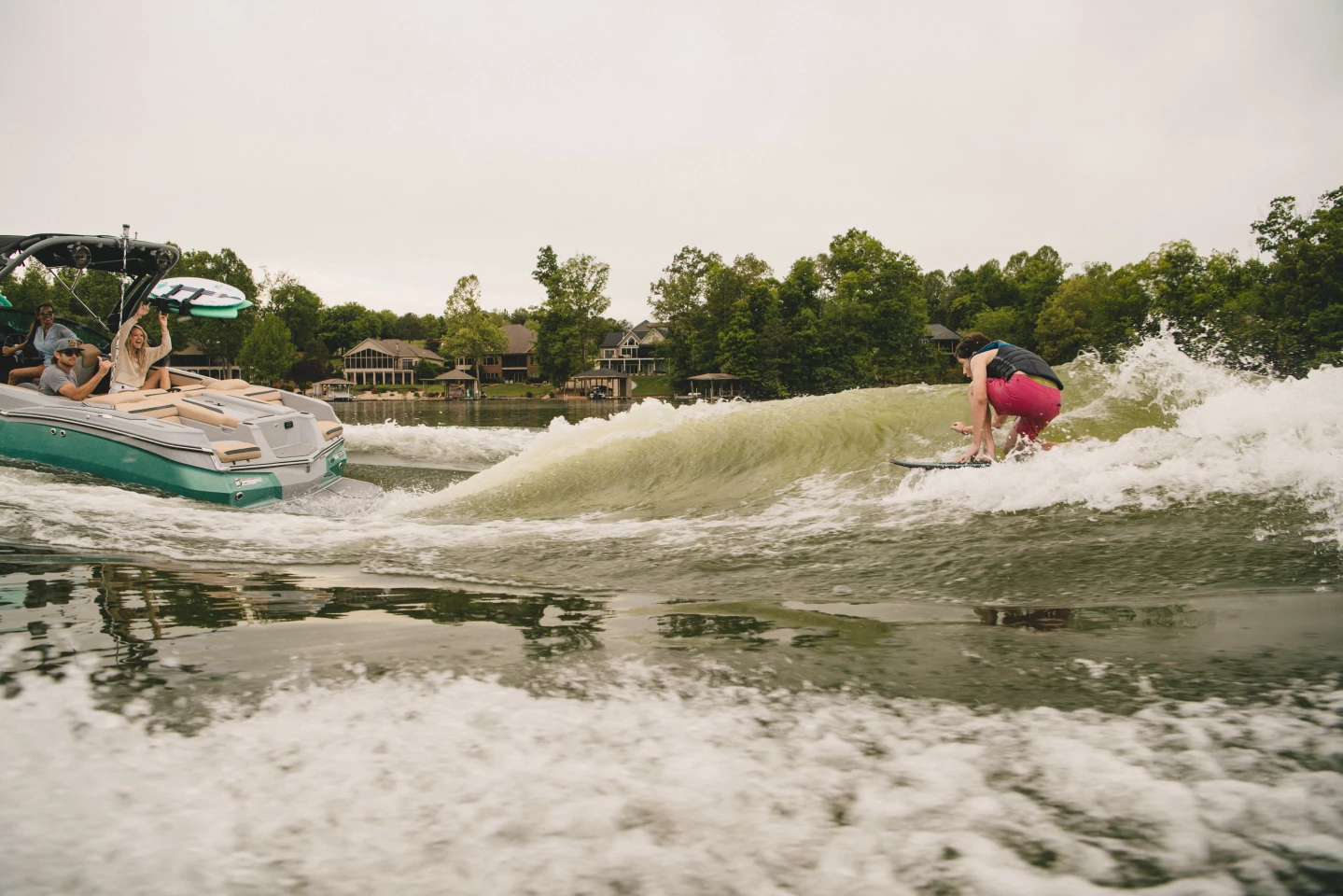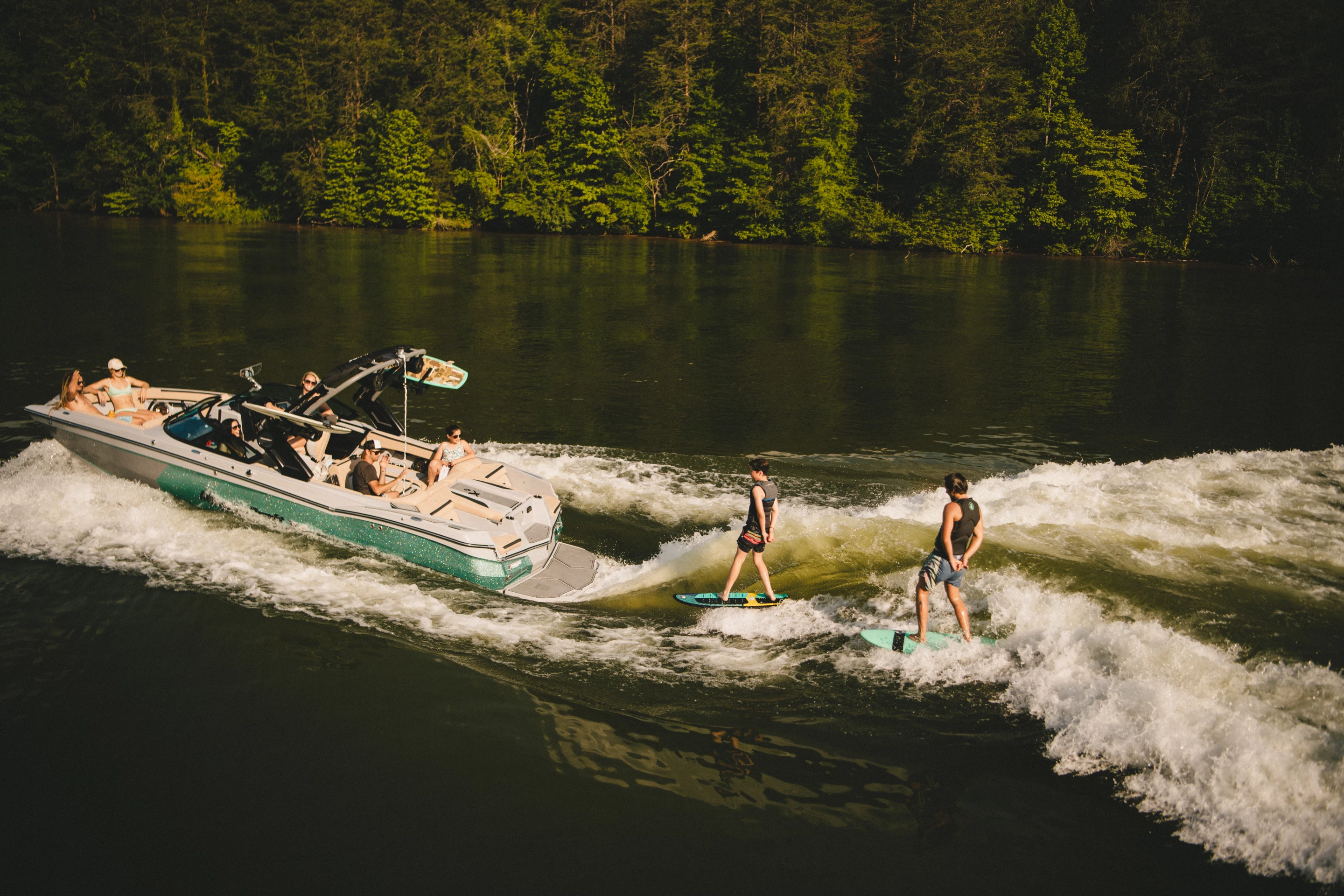Wakesurfing is nothing new. Ever since boats became capable of pulling someone behind them, the idea of jumping and playing on the waves created by the boat has been a thing. Today, however, technology has improved this activity immensely – thanks largely to companies like MasterCraft.
The primary problem with wakesurfing or wake jumping (depending on where you’re from, and what you’re riding on the water) is that the waves behind most motor boats are unpredictable. They are sometimes large, sometimes small, sometimes choppy, sometimes smooth. Weather conditions, the depth of the boat’s propeller, the shape of the boat’s hull, and a lot of other factors cause variance in the quality of the waves produced. Modern wakesurfing boats use systems to mitigate or control these variables.
We spoke with engineers at MasterCraft, the boatmaker credited with inventing modern wakesurfing systems, to find out how the whole thing comes together. There’s a lot of kit involved in this seemingly simple process, and MasterCraft has named its system SurfStar. This setup is a combination of a touchscreen user interface, a computer, and some physical "paddles." What at first glance looks pretty simple turns out to be full of technologies working together.

Early wakesurfing systems, seen in the 1960s and into the 1980s, were often bolt-on setups added by home do-it-yourselfers with fixed or deployable designs. They involved metal or wooden plates that would push down off the rear of the boat’s hull to create waves. Barely a step up from what naturally occurs behind a boat, these were the start of a whole industry that evolved around the idea of jumping and surfing on the waves behind boats.
The dangers of outboard motors, engine exhaust, etc. were and can still be hazards of the sport. V-drive boats, with the propeller well underneath the craft, and with exhaust systems made to push into the water instead of out into the air, are the safest choice. Modern boat designs allow ballast to be distributed, to change how low the hull sits in the water, which in turn changes the wake’s depth and shape.

The user interface and computer
The SurfStar system allows users to only select wave size and type, or to customize them further with more control over the variables involved. Its user interface includes what are called Rapid Surf settings, for designing and saving waves to the surfer’s preference. That interface is key to the experience on new MasterCraft boats. The UI is a series of sliders and graphics showing wave shapes followed by optional deeper customizations (called Custom Surf) that utilize numbers and allow more control over variables like ballast and speeds.
The waves to either side of the boat can be customized individually as well. So, for example, choppier "go fast" waves on the left accompanied by taller, curvier waves on the right could lead to speed and higher air. The waves a surfer might need while freely riding behind the boat versus one being pulled by the boat need to be different and offer another customization opportunity.

"The SurfStar software controls boat speed via a GPS speed control system called ZeroOff," MaserCraft explained. "When the wave is adjusted within the 1-7 spectrum (Rapid Surf interface), both speed and surf device position automatically adjust to shape the wave: 1 being the most mellow and 7 being the steepest/having the most amplitude."
Waves trough-to-peak heights range from approximately 2 feet (61 cm) to over 4 feet (122+ cm). Actual wave heights will depend on the ballast of the boat and the prevailing waves, among other factors. But MasterCraft says that its system strives for predictability with wave heights and shapes.

The hardware
The physical hardware doing the job is a combination of propeller position, exhaust outlets, computer-controlled actuators, and specially-shaped paddles. The computer in the SurfStar system controls boat speed and paddle position to create the waves behind. The paddles themselves are controlled by heavy-duty actuators. These push and pull the paddles, to create the waves requested. A third paddle, positioned at the center, controls the interference from the propeller as well as trough depth for the waves.
With the paddles actuated, we’d expect some pull to one side or the other. We asked about this and how MasterCraft dealt with it. "Our external hull devices are really just an extension of the natural running surface of the boat (not swinging out to the side and creating excessive drag)," the company responded. "As a result, our system has a minimal amount of yaw when surf modes are activated."

The shape and position of the paddles in deployment creates J-shaped waves, which are more ideal for surfing. MasterCraft says this is due to the more downward instead of outward push of the wakemaker paddles. The speed of the boat finishes the shaping.
We were surprised at how much technology and engineering went into something as simple as wakesurfing. It’s an easy sport to learn and a fun one in which to engage. It’s generally slower than water skiing, has less impact on falls as a result of that, and is easier to learn (due to the consistencies of speed and wave quality) than shore surfing. It’s also comparably less reliant on the skill of the boat’s driver.
Company website: MasterCraft










